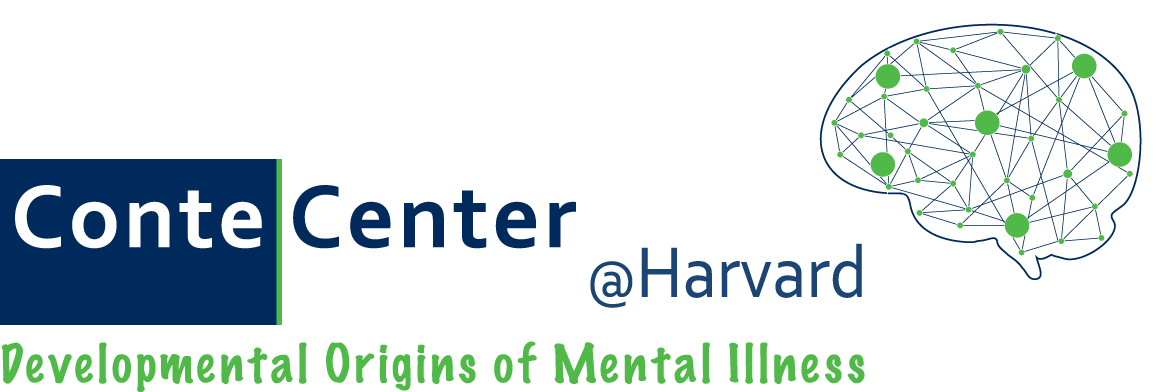Xiaowei Zhuang, PhD
Professor of Chemistry and Chemical Biology
Professor of Physics
Howard Hughes Medical Institute Investigator
Email: zhuang@chemistry.harvard.edu
Lab website: http://zhuang.harvard.edu/index.html
Our group works on the forefront of single-molecule biology and bioimaging, developing and applying advanced optical imaging techniques to study the behavior of biomolecules and molecular assemblies in vitro, in live cells and in tissues. As part of the Conte Center, we are using super-resolution microscopy to study synapses in brain circuits believed to be disrupted in mental illness.
Several advantages make light microscopy a particularly powerful tool for cell, tissue and animal imaging. These include the exquisite molecular specificity, the relatively fast time resolution and the non-invasive imaging nature. However, the spatial resolution of far-field optical microscopy, classically limited by the diffraction of light to a few hundred nanometers, is substantially larger than typical molecular length scales in cells. This limit leaves many biological problems beyond the reach of light microscopy. To overcome this limit, we have developed a new form of super- resolution light microscopy, stochastic optical reconstruction microscopy (STORM).
STORM uses photo-switchable fluorescent probes to temporally separate the otherwise spatially overlapping images of individual molecules, allowing the construction of high-resolution images. Using this concept, we have achieved three-dimensional, multicolor fluorescence imaging of molecular complexes, cells, and tissues with ~10 nm lateral and ~20 nm axial resolutions. We have also achieved live-cell STORM imaging with ~1 sec time resolution.
Recently, we have started using this new form of fluorescence microscopy to visualize the distributions and molecular architecture of chemical synapses in the brain. To investigate the developmental basis of mental illness, we will study how the synapse distribution of a specific population of inhibitory interneurons in the prefrontal cortex—believed to be particularly vulnerable in mental illness—changes during cortical development, and how it differs in healthy mice versus models of early life stress, autism, or schizophrenia. This will hopefully improve both our basic understanding of the development of prefrontal circuits and our knowledge of synapse pathology in psychiatric disorders.
About Professor Zhuang
Xiaowei Zhuang is Professor of Chemistry and Chemical Biology and Professor of Physics at Harvard University, and an Investigator of the Howard Hughes Medical Institute. Zhuang is an expert in single-molecule biology and bioimaging. Her lab develops and applies advanced optical imaging techniques, such as super-resolution light microscopy and single-molecule imaging approaches, to study biological systems quantitatively. Her single-molecule studies have yielded fundamental understandings of nucleic-acid folding and nucleic-acid-protein interactions. Her lab recently invented a super-resolution fluorescence microscopy method, STORM, which breaks the diffraction limit and allows fluorescence imaging with nanometer-scale resolution. This innovation has been used generated new insights into cellular structures. Zhuang received her B.S. degree in Physics from the University of Science and Technology of China, and her Ph.D. Degree in Physics from University of California at Berkeley. In 2001, she joined the faculty of Harvard University as an assistant professor. She was promoted to associate professor in 2005 and full professor in 2006. Zhuang received numerous awards, including the MacArthur Fellowship, Sloan Fellowship, Packard Fellowship for Science and Engineering, Beckman Young Investigator Award, Searle Scholar award, NSF CAREER award, ONR Young investigator award, TR Worlds Top 100 Young Innovators Award, Camille Dreyfus Teacher-Scholar Award, Coblentz Award, ACS Pure Chemistry Award, HHMI Collaborative Innovation Award, APS Max Delbruck Prize in Biological Physics and Raymond & Beverly Sackler International Prize in Biophysics, etc.
Professor Zhuang’s Lab Website >>
Professor Zhuang’s HHMI Profile >>
Selected Publications
Single-molecule super-resolution imaging of chromosomes and in situ haplotype visualization using Oligopaint FISH probes.
Beliveau BJ, Boettiger AN, Avendaño MS, Jungmann R, McCole RB, Joyce EF, Kim-Kiselak C, Bantignies F, Fonseka CY, Erceg J, Hannan MA, Hoang HG, Colognori D, Lee JT, Shih WM, Yin P, Zhuang X, Wu CT.
Nat Commun. 2015 May 12;6:7147.
RNA imaging. Spatially resolved, highly multiplexed RNA profiling in single cells.
Chen KH, Boettiger AN, Moffitt JR, Wang S, Zhuang X.
Science. 2015 Apr 24;348(6233):aaa6090.
Correlative stochastic optical reconstruction microscopy and electron microscopy.
Kim D, Deerinck TJ, Sigal YM, Babcock HP, Ellisman MH, Zhuang X.
PLoS One. 2015 Apr 15;10(4):e0124581.
Developmental mechanism of the periodic membrane skeleton in axons.
Zhong G, He J, Zhou R, Lorenzo D, Babcock HP, Bennett V, Zhuang X.
Elife. 2014 Dec 23;3.
A PIK3C3-ankyrin-B-dynactin pathway promotes axonal growth and multiorganelle transport.
Lorenzo DN, Badea A, Davis J, Hostettler J, He J, Zhong G, Zhuang X, Bennett V.
J Cell Biol. 2014 Dec 22;207(6):735-52.
Characterization and development of photoactivatable fluorescent proteins for single-molecule-based superresolution imaging.
Wang S, Moffitt JR, Dempsey GT, Xie XS, Zhuang X.
Proc Natl Acad Sci U S A. 2014 Jun 10;111(23):8452-7
Actin, spectrin, and associated proteins form a periodic cytoskeletal structure in axons.
Xu K, Zhong G, Zhuang X.
Science. 2013 Jan 25;339(6118):452-6.
3D multicolor super-resolution imaging offers improved accuracy in neuron tracing.
Lakadamyali M, Babcock H, Bates M, Zhuang X, Lichtman J.
PLoS One. 2012;7(1):e30826.
Dual-objective STORM reveals three-dimensional filament organization in the actin cytoskeleton.
Xu K, Babcock HP, Zhuang X.
Nat Methods. 2012 Jan 8;9(2):185-8.
Superresolution imaging of chemical synapses in the brain.
Dani A, Huang B, Bergan J, Dulac C, Zhuang X.
Neuron. 2010 Dec 9;68(5):843-56.
In the News
New Method Allows Precise Measurement of Transcriptome in Single Cells
2015 HHMI News
Three faculty members receive NAS awards
2015 Harvard Gazette news story
Scientists discover a periodic and ringed cytoskeleton within axons
2013 HHMI News
In Finer Focus
2013 Proto Magazine article
AAAS names 7 fellows from Harvard
2012 Harvard Gazette news story
Imaging instruction: Researchers produce ‘primer’ to guide the use of STORM
2011 Harvard Gazette article
Microscopy: Bright light, better labels
2011 Nature Technology Feature
Nikon announces agreement for use of innovative Harvard STORM technology
2009 Nikon news story
A Better Wiring Guide to the Mammalian Brain
2008 HHMI Research News
New Microscopy Technique Transforms Millions of Points of Light into Detailed 3D Images
2008 HHMI Research News
Researchers Zoom in on Life in Technicolor
2007 HHMI Research News

